Related Research Articles

James Benjamin Blish was an American science fiction and fantasy writer. He is best known for his Cities in Flight novels and his series of Star Trek novelizations written with his wife, J. A. Lawrence. His novel A Case of Conscience won the Hugo Award. He is credited with creating the term "gas giant" to refer to large planetary bodies.
The New Wave was a science fiction style of the 1960s and 1970s, characterized by a great degree of experimentation with the form and content of stories, greater imitation of the styles of non-science fiction literature, and an emphasis on the psychological and social sciences as opposed to the physical sciences. New Wave authors often considered themselves as part of the modernist tradition of fiction, and the New Wave was conceived as a deliberate change from the traditions of the science fiction characteristic of pulp magazines, which many of the writers involved considered irrelevant or unambitious.

Damon Francis Knight was an American science fiction author, editor, and critic. He is the author of "To Serve Man", a 1950 short story adapted for The Twilight Zone. He was married to fellow writer Kate Wilhelm.
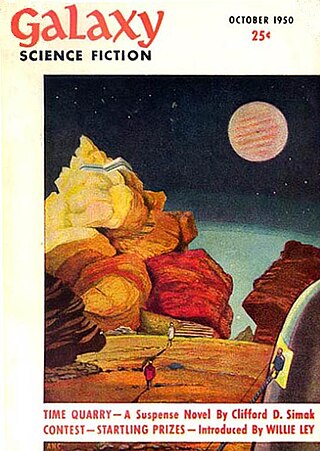
Galaxy Science Fiction was an American digest-size science fiction magazine, published in Boston from 1950 to 1980. It was founded by a French-Italian company, World Editions, which was looking to break into the American market. World Editions hired as editor H. L. Gold, who rapidly made Galaxy the leading science fiction magazine of its time, focusing on stories about social issues rather than technology.
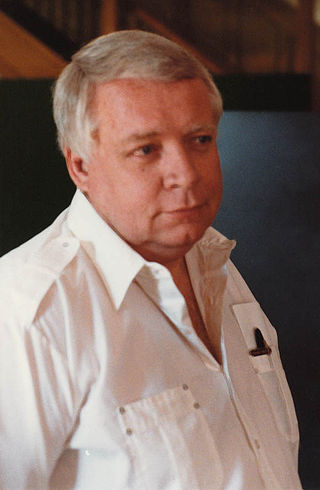
Algirdas Jonas "Algis" Budrys was a Lithuanian-American science fiction author, editor, and critic. He was also known under the pen names Frank Mason, Alger Rome in collaboration with Jerome Bixby, John A. Sentry, William Scarff, and Paul Janvier. In 1960, he authored Rogue Moon, a novel.
Lester del Rey was an American science fiction author and editor. He was the author of many books in the juvenile Winston Science Fiction series, and the editor at Del Rey Books, the fantasy and science fiction imprint of Ballantine Books, along with his fourth wife Judy-Lynn del Rey.

The Magazine of Fantasy & Science Fiction is a U.S. fantasy and science fiction magazine, first published in 1949 by Mystery House, a subsidiary of Lawrence Spivak's Mercury Press. Editors Anthony Boucher and J. Francis McComas had approached Spivak in the mid-1940s about creating a fantasy companion to Spivak's existing mystery title, Ellery Queen's Mystery Magazine. The first issue was titled The Magazine of Fantasy, but the decision was quickly made to include science fiction as well as fantasy, and the title was changed correspondingly with the second issue. F&SF was quite different in presentation from the existing science fiction magazines of the day, most of which were in pulp format: it had no interior illustrations, no letter column, and text in a single-column format, which in the opinion of science fiction historian Mike Ashley "set F&SF apart, giving it the air and authority of a superior magazine".

"If There Were No Benny Cemoli" is a science fiction short story by American writer Philip K. Dick, first published in the December, 1963 issue of Galaxy magazine with illustration by Lutjens.
The Golden Age of Science Fiction, often identified in the United States as the years 1938–1946, was a period in which a number of foundational works of science fiction literature appeared. In the history of science fiction, the Golden Age follows the "pulp era" of the 1920s and 1930s, and precedes New Wave science fiction of the 1960s and 1970s. The 1950s are, in this scheme, a transitional period. Robert Silverberg, who came of age in the 1950s, saw that decade as the true Golden Age.
The Milford Writer's Workshop, or more properly Milford Writers' Conference, is an annual science fiction writer's event founded by Damon Knight, among others, in the mid-1950s, in Milford, Pennsylvania. It was so named because Knight, Judith Merril, and James Blish lived in Milford when it was founded. It moved to the United Kingdom in 1972 and has run successfully ever since on an annual basis.
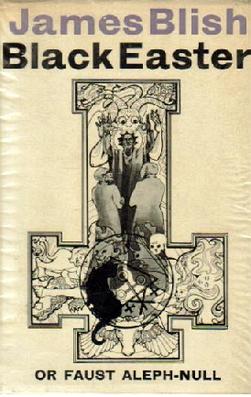
Black Easter is a fantasy novel by American writer James Blish, in which an arms dealer hires a black magician to unleash all the demons of Hell on Earth for a single day. The novel initially depicts the assassination of a Governor of California by a black magician working as a contract killer. The same magician is then hired to release every demon in Hell for a brief time period. However, the demons can not actually return to Hell by the end of the novel. Their traditional opponent, God, has already died and nobody else can compel them to return to Hell.

NESFA Press is the publishing arm of the New England Science Fiction Association, Inc. The NESFA Press primarily produces three types of books:
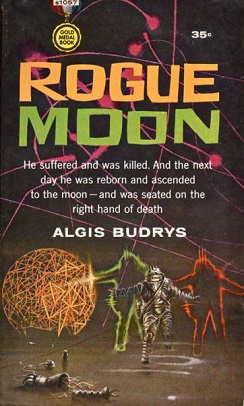
Rogue Moon is a short science fiction novel by Lithuanian-American writer Algis Budrys, published in 1960. It was a 1961 Hugo Award nominee. A substantially shortened version of the novel was originally published in F&SF; this novella-length story was included in The Science Fiction Hall of Fame, Volume Two, edited by Ben Bova. It was adapted into a radio drama by Yuri Rasovsky in 1979.

Infinity Science Fiction was an American science fiction magazine, edited by Larry T. Shaw, and published by Royal Publications. The first issue, which appeared in November 1955, included Arthur C. Clarke's "The Star", a story about a planet destroyed by a nova that turns out to have been the Star of Bethlehem; it won the Hugo Award for that year. Shaw obtained stories from some of the leading writers of the day, including Brian Aldiss, Isaac Asimov, and Robert Sheckley, but the material was of variable quality. In 1958 Irwin Stein, the owner of Royal Publications, decided to shut down Infinity; the last issue was dated November 1958.
Science fiction studies is the common name for the academic discipline that studies and researches the history, culture, and works of science fiction and, more broadly, speculative fiction.
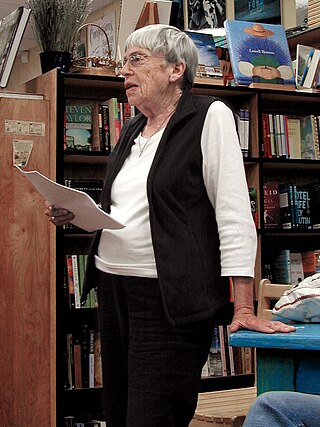
Soft science fiction, or soft SF, is a category of science fiction with two different definitions, defined in contrast to hard science fiction. It can refer to science fiction that explores the "soft" sciences, as opposed to hard science fiction, which explores the "hard" sciences. It can also refer to science fiction which prioritizes human emotions over the scientific accuracy or plausibility of hard science fiction.

In Search of Wonder: Essays on Modern Science Fiction is a collection of critical essays by American writer Damon Knight. Most of the material in the original version of the book was originally published between 1952 and 1955 in various science fiction magazines including Infinity Science Fiction, Original SF Stories, and Future SF. The essays were highly influential, and contributed to Knight's stature as the foremost critic of science fiction of his generation. The book also constitutes an informal record of the "Boom Years" of science fiction from 1950 to 1955.

Science Fiction: The 100 Best Novels, An English-Language Selection, 1949–1984 is a nonfiction book by David Pringle, published by Xanadu in 1985 with a foreword by Michael Moorcock. Primarily, the book comprises 100 short essays on the selected works, covered in order of publication, without any ranking. It is considered an important critical summary of the science fiction field.

The following outline is provided as an overview of and topical guide to science fiction:
"Nobody Bothers Gus" is a 1955 science fiction short story by Algis Budrys. It was first published in Astounding Science-Fiction.
References
- ↑ For example, Patrick Parrinder comments that "[d]efinitions of science fiction are not so much a series of logical approximations to an elusive ideal, as a small, parasitic subgenre in themselves." Parrinder, Patrick (1980). Science Fiction: Its Criticism and Teaching. London: New Accents.
- ↑ Stableford, Brian; Clute, John; Nicholls, Peter (1993). "Definitions of SF". In Clute, John; Nicholls, Peter (eds.). Encyclopedia of Science Fiction. London: Orbit/Little, Brown and Company. pp. 311–314. ISBN 1-85723-124-4.
- ↑ Shippey, Tom (1991) Fictional Space. Essays on Contemporary Science Fiction, page 2, Humanities Press International, Inc., NJ
- ↑ Suvin, Darko (1979) Metamorphoses of Science Fiction: On the Poetics and History of a Literary Genre, New Haven, pp. 63–84.
- ↑ Originally published in the April 1926 issue of Amazing Stories
- 1 2 3 4 5 6 7 8 9 Quoted in [1993] in: Stableford, Brian; Clute, John; Nicholls, Peter (1993). "Definitions of SF". In Clute, John; Nicholls, Peter (eds.). Encyclopedia of Science Fiction. London: Orbit/Little, Brown and Company. pp. 311–314. ISBN 1-85723-124-4.
- ↑ Originally published in Pilgrims of Space and Time (1947)
- 1 2 3 4 Quoted in Jakubowski, Maxim; Edwards, Malcolm, eds. (1983) [1983]. The Complete Book of Science Fiction and Fantasy Lists . London: Granada. ISBN 0-586-05678-5.
- 1 2 Originally in Eshbach, Lloyd Arthur, ed. (1947). Of Worlds Beyond. New York: Fantasy Press. p. 91.; cited from 1964 reprint.
- ↑ Budrys, Algis (October 1967). "Galaxy Bookshelf". Galaxy Science Fiction. pp. 188–194.
- ↑ Smith, George O. (1975). Venus Equilateral. London: Futura Publications. pp. 9–10.
- ↑ Knight, Damon (1952). "Science Fiction Adventures". Science Fiction Adventures (1952 magazine) (1): 122. Punctuation was misprinted in the original magazine; the quote is punctuated as Knight had it in his collection of essays In Search of Wonder , Chicago: Advent, 1956.
- ↑ James Blish, writing as William Atheling, Jr., cited this definition of Sturgeon's from a talk he had given. Blish's article was published in the Autumn 1952 issue of Red Boggs' fanzine Skyhook. Sturgeon subsequently complained to Blish that he had intended the definition to apply only to good science fiction. Atheling Jr., William (1967). The Issue At Hand. Chicago: Advent. p. 14.
- ↑ Davenport, Basil (1955). Inquiry Into Science Fiction . New York: Longmans, Green and Co. p. 15.
- ↑ Wyndham, John (1963). The Seeds of Time. Harmondsworth: Penguin. p. 7., quoted from the Penguin reprint; the original publication was 1956 by Michael Joseph.
- ↑ "Definitions of Science Fiction". Archived from the original on 18 October 2006. Retrieved 3 December 2006.
- ↑ From Heinlein's essay "Science Fiction: Its Nature, Faults and Virtues", originally in Davenport, Basil, ed. (1959). The Science Fiction Novel: Imagination and Social Criticism. Advent.; cited from Knight, Damon, ed. (1977). Turning Points:Essays on the Art of Science Fiction . New York: Harper and Row. p. 9. ISBN 9780060124328.
- ↑ Amis, Kingsley (1960). New Maps of Hell. New York: Ballantine. p. 14.
- ↑ Atheling, William Jr. Science-Fantasy and Translations: Two More Cans of Worms in Atheling, William Jr (1970). Blish, James (ed.). More issues at hand; critical studies in contemporary science fiction . Chicago: Advent. p. 100. ISBN 978-0-911682-10-6. According to the front matter, this essay was originally published in two parts, in 1960 and 1964. Blish, writing as William Atheling, Jr., lists a variety of sources, some fanzines and some professional magazines, from which the book was drawn, but does not specify which particular sources formed the basis of this essay.
- ↑ Rod Serling (1962-03-09). The Twilight Zone, "The Fugitive".
- ↑ Parrinder, Patrick (2000). Learning from Other Worlds . Liverpool: Liverpool University Press. p. 300.
- ↑ Clareson, Thomas D. (1971). Sf: The Other Side of Realism. Bowling Green, OH: Bowling Green University Popular Press. p. 60.
- ↑ Quoted by Algis Budrys in a review of Best SF: 1967. Budrys, Algis (November 1968). "Galaxy Bookshelf". Galaxy Science Fiction. pp. 160–166.
- ↑ Budrys, Algis (September 1968). "Galaxy Bookshelf". Galaxy Science Fiction. pp. 187–193.
- ↑ Pohl, Frederik (December 1968). "The Great Inventions". Editorial. Galaxy Science Fiction. pp. 4–6.
- ↑ Originally published in 1972
- ↑ Aldiss, Brian (1973). Billion Year Spree . Garden City, N.Y., Doubleday. ISBN 9780385088879.
- ↑ Aldiss, Brian; Wingrove, David (1986). Trillion Year Spree: The History of Science Fiction . London: Gollancz. ISBN 0-575-03942-6.
- ↑ Farrell, Edmund J.; Gage, Thomas E.; Pfordresher, John; et al., eds. (1974). Science Fact/Fiction. Scott, Foresman and Company. Introduction by Ray Bradbury.
- ↑ The quote is from the introduction to Spinrad, Norman, ed. (1974). Modern Science Fiction . Anchor Press. ISBN 9780385022637.
- ↑ Asimov, "How Easy to See the Future!", Natural History, 1975
- 1 2 Scholes, Robert (1975). Structural Fabulation . ISBN 9780268005702.
- ↑ Scholes, Robert; Rabkin, Eric S. (1977). Science Fiction: History, Science, Vision . London: Oxford University Press. ISBN 978-0-19-502174-5.
- ↑ Road to Science Fiction Vol 1.
- ↑ Metamorphoses of SF No 63.
- 1 2 Parrinder, Patrick (1980). Science Fiction: Its Criticism and Teaching. London: New Accents. p. 15.
- ↑ Dick, Philip K. (1995). The shifting realities of Philip K. Dick : selected literary and philosophical writings. Edited and with an introduction by Lawrence Sutin (1st Vintage Books ed.). New York: Vintage Books. ISBN 0679747877. OCLC 35274535.
- ↑ Malzberg, Barry N. (1982). "The Number of the Beast". The Engines of the Night : Science Fiction in the Eighties. Doubleday. In an preview of this book, Malzberg wrote "past" rather than "future": Malzberg, Barry N. (August 1981). "The Engines of the Night: The Number of the Beast" (PDF). Science Fiction Review (40): 19–22.
- ↑ Pringle, David (1985). Science Fiction: The 100 Best Novels. London: Xanadu. p. 9.
- ↑ Robinson, Kim Stanley (1987). "Toward a Definition of "Science Fiction"". Foundation: the international review of science fiction (40). ISSN 0306-4964. Archived from the original on December 1, 2014. Retrieved 2014-12-01.
- ↑ Evans, Christopher (1988). Writing Science Fiction. London: A & C Black. p. 9.
- ↑ Greenberg, Martin; Asimov, Isaac, eds. (1990). Cosmic Critiques. Cincinnati: Writer's Digest Books. p. 6.
- ↑ Clarke, Arthur C. (2000). Patrick Nielsen Hayden (ed.). The Collected Stories of Arthur C. Clarke. New York: Orb Books. p. ix. ISBN 0-312-87860-5.
- ↑ Prucher, Jeff (2007). Brave New Words. Oxford: Oxford University Press. p. 171.
- ↑ Card, Orson Scott (September 28, 2010). "Defining Science Fiction and Fantasy". Writer's Digest. Retrieved December 21, 2023.
- ↑ Humans have visited the Moon.
- ↑ Milner, Andrew (2012). Locating Science Fiction . Liverpool: Liverpool University Press. pp. 39–40.
- ↑ Pandey, Ashish (2005). Academic Dictionary of Fiction. Delhi, India: Isha Books. p. 137. ISBN 9788182052628 . Retrieved 3 October 2011.
- ↑ Malzberg, Barry N. (August 1981). "The Engines of the Night: The Number of the Beast" (PDF). Science Fiction Review (40): 19–22.